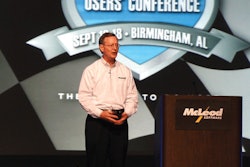When it comes to integration, the sky’s the limit for Daimler

The term “vertical integration” has been thrown around a lot the past year, especially among Class 8 truck OEMs. Volvo has its XE13 powertrain package that includes a D13 engine and I-Shift transmission. Mack this year introduced its Pedigree powertrain that includes its proprietary engine, transmission and axles. And this year certainly has been big in the way of product rollout for Daimler, which has introduced proprietary Detroit-branded axles and its DT12 transmission to complement its DD15 engine platform.
All this has been done with the theory that OEM components will work better together than a powertrain sourced from one or more third-party powertrain component suppliers. On the surface at least, the theory makes sense. After all, OEMs certainly aren’t going to share the “secret sauce” in their engine recipes, and going vertical with powertrain components allows them to maximize communication potential through proprietary software and achieve greater fuel efficiency.
 Mercedes-Benz says its “Aerodynamic Truck & Trailer” concept results in 18 percent less air resistance and almost 5 percent improvement in fuel consumption.
Mercedes-Benz says its “Aerodynamic Truck & Trailer” concept results in 18 percent less air resistance and almost 5 percent improvement in fuel consumption.At a press conference at the IAA 2012 show in Hanover, Germany, Stefan Buchner, head of global powertrain, procurement and manufacturing engineering for Daimler, said the company’s North American goals for market penetration were 85 percent for Detroit engines, 60 and 40 percent for front and rear axles, respectively, and a long-range goal of 15 percent for the DT12 transmission that will be available next year with the DD15 and DD13 engines.
If you think, like I did before attending this year’s IAA, that vertical integration stops at the powertrain, you’d be wrong. As Daimler clearly displayed at the show, it can and is leveraging know-how from its automotive and European truck businesses to further blur the lines between OEM and aftermarket.
The first example at IAA occurred before the show even began, when Daimler shuttled about 400 members of the international press to a nearby test track to demonstrate its new Active Brake Assist 3 (ABA3) available overseas on new Actros and Antos cabover tractors.
Putting its money where its mouth is, the company simulated a traffic jam by parking three C-Series sedans on the track. A driver in an Actros tractor-trailer then drove at highway speed straight toward the rear car without braking. The ABA3 system detected the traffic ahead and applied 100 percent braking force, bringing the truck to a complete stop a comfortable distance from the car ahead.
At a press roundtable later in the show, Wilfried Achenbach, head of engineering for DTNA, said the company plans to introduce its ABA3 technology globally sooner rather than later, hinting that it will be available in North America on Cascadias within five years, complementing the company’s offering of Meritor Wabco and Eaton collision avoidance systems.
Daimler also introduced its “Aerodynamic Truck & Trailer” concept, a new Actros StreamSpace cab with side and roof fairings paired with a Mercedes-Benz-developed aerodynamic trailer package that includes a trailer bulkhead spoiler, plastic side trim panels, a rear diffuser that surrounds the underride guard and a 400-mm “boat tail” rear taper. Together, company officials said the tractor-trailer aerodynamics package reduces air resistance by 18 percent and improves fuel consumption by nearly 5 percent.
“Our engineers have never considered the truck in isolation,” says Georg Weiberg, head of product engineering for Daimler Trucks. “Truck and trailer go together like screw and screwdriver, wheel and tire, pen and paper. There is no point to one without the other.”
Whether the aerodynamic package makes it to North America is yet to be seen, but these are two examples of ways in which OEM product integration is extending past the rear axle.











